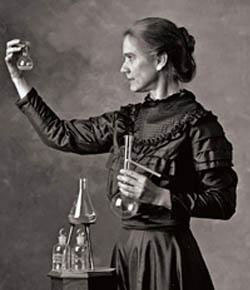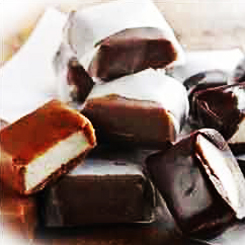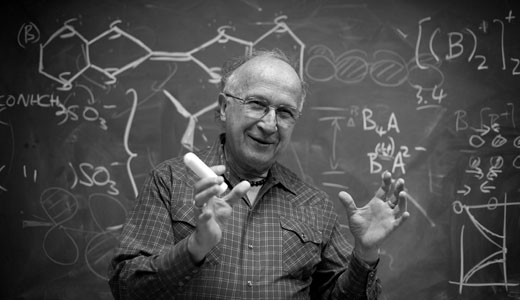 In 1911, Marie Curie was awarded her second Nobel Prize; in 2011, the United Nations declared that this year would be the International Year of Chemistry, in large part because this is the 100th anniversary of Marie Skłodowska-Curie’s Nobel Prize in Chemistry. The January-February issue of The News Magazine of the International Union of Pure and Applied Chemistry (IUPAC) is devoted entirely to Madame Curie and produced under the direction of a French-Polish editorial board.
In 1911, Marie Curie was awarded her second Nobel Prize; in 2011, the United Nations declared that this year would be the International Year of Chemistry, in large part because this is the 100th anniversary of Marie Skłodowska-Curie’s Nobel Prize in Chemistry. The January-February issue of The News Magazine of the International Union of Pure and Applied Chemistry (IUPAC) is devoted entirely to Madame Curie and produced under the direction of a French-Polish editorial board.
In 1995, the President of France, François Mitterrand, then dying of cancer, decided to honour “the women of France,” and with great ceremony he arranged for the internment of the ashes of Marie and Pierre Curie in the Pantheon where, on its façade, was the inscription: “To Great Men from a Grateful Nation.” And thus was Marie Curie the first woman to be buried there for her own accomplishments. All this was accompanied by a cortège that moved along a white-carpeted rue Soufflot, tricolor banners, the resounding chorus of the Marseillaise, marching Republican Guardsmen, school children, and thousands of Parisians tossing flowers in the path of the cortège. Lech Wałęsa shared the podium with Mitterrand in a gesture of recognition for Skłodowska-Curie’s national origin.
Of course by 1995, Skłodowska-Curie had been widely honored, and not just as a remarkable woman. A brief recapitulation of her career may be in order.
In 1893, she was the first woman to earn a degree in physics at the Sorbonne and, the following year, the first woman to earn a degree in mathematics there. She was the first woman to be appointed professor at the Sorbonne and the first woman to win two Nobel Prizes, the first in physics, the second in chemistry. Indeed, she is the first person of either gender to win two Nobels in two different fields of science. (Linus Pauling received two Nobels but one of them was a Peace Prize.) Certainly no other Nobel Prize winner had a daughter who also won the Nobel! Her daughter, Irene, won it in 1935 together with her husband, Frederic Joliot.
Madame Curie was the first woman to be elected to the French Academy of Medicine. Stamps and coins bear her image. The French Academy of Science, however, refused to accept her and it was not until 1962 that a woman was finally accepted. That was Marguerite Perey, ironically, one of Skłodowska-Curie’s doctoral students.
Skłodowska-Curie was one of five children born in Warsaw, where her mother was a director of a private girls’ school and her father a scientist and a professor. This part of Poland being then in the Russian zone of occupation during the partitions, both the parents’ careers, and the education of children, were severely restricted, but both parents maintained high expectations for their daughters. Once the girls finished high school, where forbidden subjects were easily concealed from Russian inspectors, they pursued their advanced studies in secret illegal “Flying Universities”; these underground educational programs set an example for future generations who studied in secret during the WWII German occupation, which forbade it, and subsequently the Soviet occupations which controlled it.
Madame Curie herself gives much credit to her secret education. The year before she left for Paris she worked in a laboratory with Professor Józef Boguski, and she also studied with Napoleon Milicer and Ludwik Kossakowski without whom, she said: “If [they] hadn’t given me a sound grasp of analysis in Warsaw, I would never have separated out radium.”
Madame Curie’s honors are many. In 1921, President Harding presented her with funds to purchase one gram of radium for the Marie Curie Institute in Paris; in 1929, President Hoover presented her with a gift of $50,000, on behalf of American Friends of Science, to purchase radium for the Curie Institute in Warsaw – which she also established.
The number of research institutions, medical facilities and schools named for her are too numerous to mention. Stamps and coins all over the world bear her image.
In her native Poland, she received honorary doctorates from Lwów Polytechnic (1912), Poznań University (1922), Jagiellonian University in Kraków (1924), and Warsaw Polytechnic (1936).
In 1935, a  statue of Skłodowska-Curie was unveiled in front of Warsaw’s Radium Institute. It was damaged, but not destroyed, during the 1944 Warsaw Uprising; after the war it was returned to its place, its bullet scars a symbol of Curie’s and Poland’s resilience.
statue of Skłodowska-Curie was unveiled in front of Warsaw’s Radium Institute. It was damaged, but not destroyed, during the 1944 Warsaw Uprising; after the war it was returned to its place, its bullet scars a symbol of Curie’s and Poland’s resilience.
The most recent book about her, “Radioactive,” is reviewed in this issue. A brief mention of other biographies is required.
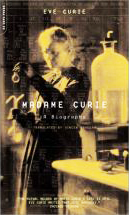 The first, “Madame Curie,” was written by her daughter, Eve, a successful journalist with an independent spirit in the Skłodowska mold. Eve Curie writes extensively about her mother’s formative years, including the family tradition of excellence and patriotism. This 1938 publication does not even mention the public attacks her mother endured at the hands of the French media and intellectual establishment because of her relationship with a married man. Perhaps loyalty to her mother influenced Eve Curie’s refusal to acknowledge the jackals and their gleeful spite. Or it could simply be the natural reserve of another era, coupled with her mother’s cultural tendency, a Polish one, to leave a private life private. Of course, Eve Curie was well aware that keeping one’s private life private was a privilege that French men always enjoyed even though they denied this dignity to the greatest scientist among them simply because she was a woman. Whatever the reason, it was a good thing to do. This book inspired thousands of girls to embark on a scientific career, and still does, and that is a very positive effect that would have pleased the scientist.
The first, “Madame Curie,” was written by her daughter, Eve, a successful journalist with an independent spirit in the Skłodowska mold. Eve Curie writes extensively about her mother’s formative years, including the family tradition of excellence and patriotism. This 1938 publication does not even mention the public attacks her mother endured at the hands of the French media and intellectual establishment because of her relationship with a married man. Perhaps loyalty to her mother influenced Eve Curie’s refusal to acknowledge the jackals and their gleeful spite. Or it could simply be the natural reserve of another era, coupled with her mother’s cultural tendency, a Polish one, to leave a private life private. Of course, Eve Curie was well aware that keeping one’s private life private was a privilege that French men always enjoyed even though they denied this dignity to the greatest scientist among them simply because she was a woman. Whatever the reason, it was a good thing to do. This book inspired thousands of girls to embark on a scientific career, and still does, and that is a very positive effect that would have pleased the scientist.
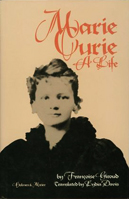 A 1987 biography, “Marie Curie: A Life,” by Françoise Giroud provides an interesting look at Madame Curie in her scientific milieu, including her friends Albert Einstein, Henri Poincaré, Ernest Rutherford, and Max Planck to name a few. A notable comment by Rutherford: “Madame Curie is a hard person to handle. She has at once the advantage and the inconvenience of being a woman.” She became more famous than any of them but, as noted by Einstein: “Marie Curie is, of all celebrated beings, the one whom fame has not spoiled.” Giroud provides an interesting social history, one that women in science still find not altogether unchanged.
A 1987 biography, “Marie Curie: A Life,” by Françoise Giroud provides an interesting look at Madame Curie in her scientific milieu, including her friends Albert Einstein, Henri Poincaré, Ernest Rutherford, and Max Planck to name a few. A notable comment by Rutherford: “Madame Curie is a hard person to handle. She has at once the advantage and the inconvenience of being a woman.” She became more famous than any of them but, as noted by Einstein: “Marie Curie is, of all celebrated beings, the one whom fame has not spoiled.” Giroud provides an interesting social history, one that women in science still find not altogether unchanged.
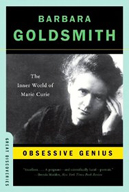 More recently, Barbara Goldsmith wrote “Obsessive Genius: The Inner World of Marie Curie,” published in 2005. When she was a teenager, Goldsmith’s idol was Marie Curie, her photograph with her two daughters hanging prominently on her bedroom bulletin board. The scientist of the century and a mother of two, a single mother for much of the time. Truly inspirational.
More recently, Barbara Goldsmith wrote “Obsessive Genius: The Inner World of Marie Curie,” published in 2005. When she was a teenager, Goldsmith’s idol was Marie Curie, her photograph with her two daughters hanging prominently on her bedroom bulletin board. The scientist of the century and a mother of two, a single mother for much of the time. Truly inspirational.
Goldsmith does not, can not, ignore the scandal that Eve Curie chose to omit completely, but then, it’s a different time. It’s a well-written, well-researched book, and a pleasure to read.
Both Goldsmith’s and Grioud’s books are geared to the contemporary reader, American or French, and tend to skim over Skłodowska-Curie’s formative years which is a pity. Madame Curie did not begin her life in Paris, nor as a married woman, still less as a widow who had an affair. Formative years are important, especially when they are lived in an atmosphere as intense and passionate as that of the Skłodowskis. In today’s world, the freedom to study is probably not appreciated enough, while striving for excellence is diluted in a culture of affluence and consumerism.
Eve Curie’s book is still the most widely read in Poland, especially by students. It deserves to be, and should be read here as much as in Poland. Madame Curie’s daughter knew how much her mother’s upbringing in Poland influenced all of her life. The social history of her time and place should not be overlooked in any study of the greatest scientist of the century. CR
Watch “The Land of My Mother,” a wartime tribute to Poland produced in New York during World War II and narrated by Eve Curie, Marie’s daughter. The film uses the only known color footage to exist of pre-war Poland, and includes an appeal for Poles & their nation under attack.
